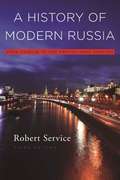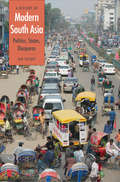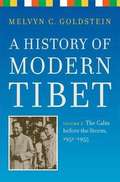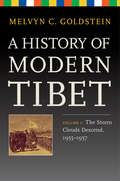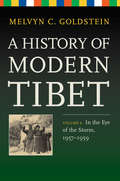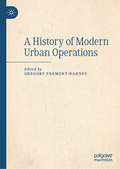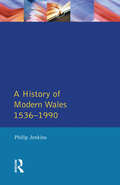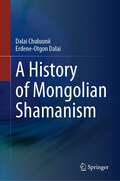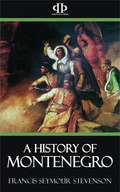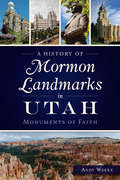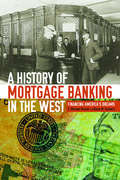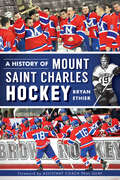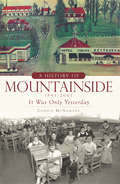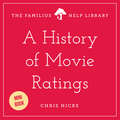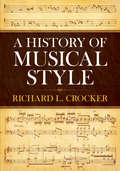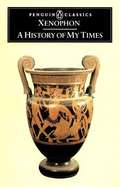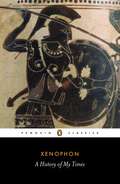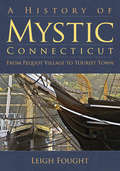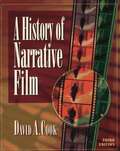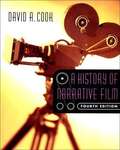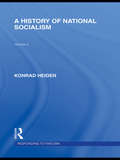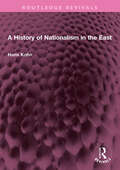- Table View
- List View
A History of Modern Russia: From Tsarism to the Twenty-First Century
by Robert ServiceRussia had an extraordinary twentieth century, undergoing upheaval and transformation. Updating his acclaimed History of Modern Russia, Robert Service provides a panoramic perspective on a country whose Soviet past encompassed revolution, civil war, mass terror, and two world wars. He shows how seven decades of communist rule, which penetrated every aspect of Soviet life, continue to influence Russia today. This new edition takes the story from 2002 through the entire presidency of Vladimir Putin to the election of his successor, Dmitri Medvedev.
A History of Modern Shanghai Banking: The Rise and Decline of China's Financial Capitalism (Studies On Modern China Ser.)
by Ji ZhaojinAs the center of capitalism in China, Shanghai banking provides a unique perspective for assessing the impact of the changes from financial capitalism to socialist planning banking in the early 1950s, and for evaluating the reform of China's banking system since the 1980s. This book offers a comprehensive history of Shanghai banking and capital markets from 1842 to 1952, and illustrates the non-financial elements that contributed to the revolutionary social and financial changes since the 1950s, as well as financial experiences that are significant to China's economic development today. The book describes the rise and fall of China's traditional native banks, the establishment of foreign banks, and the creation of modern state banks, while focusing on the colorful world of banking, finance, and international relations in modern Shanghai. It assesses the Chinese government's intervention in banking and finance during the Qing dynasty and the Republican era, as well as the concept of state capitalism after the establishment of the People's Republic. The author examines various modern-style Chinese banks through fascinating stories of Shanghai bankers. In addition, she provides detailed coverage of market-oriented international trade, banking associations, the conflicts between state and society, the government involvement in business, the management of foreign exchange, joint venture banks, wartime banking and finance, hyperinflation, corruption, and banking nationalization.
A History of Modern South Asia
by Ian TalbotNoted historian Ian Talbot has written a new history of modern South Asia that considers the Indian Subcontinent in regional rather than in solely national terms. A leading expert on the Partition of 1947, Talbot focuses here on the combined history of India, Pakistan, and Bangladesh since 1757 and specifically on the impact of external influences on the local peoples and cultures. This text explores the region's colonial and postcolonial past, and the cultural and economic Indian reaction to the years of British authority, thus viewing the transformation of modern South Asia through the lens of a wider world.
A History of Modern Tibet, Volume 2: The Calm Before the Storm, 1951-1955
by Melvyn C. GoldsteinIt is not possible to fully understand contemporary politics between China and the Dalai Lama without understanding what happened--and why--during the 1950s. In a book that continues the story of Tibet's history that he began in his acclaimed "A History of Modern Tibet, 1913-1951: The Demise of the Lamaist State," Melvyn C. Goldstein critically revises our understanding of that key period in midcentury. This authoritative account utilizes new archival material, including never before seen documents, and extensive interviews with Tibetans, including the Dalai Lama, and with Chinese officials. Goldstein furnishes fascinating and sometimes surprising portraits of these major players as he deftly unravels the fateful intertwining of Tibetan and Chinese politics against the backdrop of the Korean War, the tenuous Sino-Soviet alliance, and American cold war policy.
A History of Modern Tibet, Volume 3
by Melvyn C. GoldsteinIt is not possible to fully understand contemporary politics between China and the Dalai Lama without understanding what happened in the 1950's. The third volume in Melvyn Goldstein's History of Modern Tibet series, The Calm before the Storm, examines the critical years of 1955 through 1957. During this period, the Preparatory Committee for a Tibet Autonomous Region was inaugurated in Lhasa, and a major Tibetan uprising occurred in Sichuan Province. Jenkhentsisum, a Tibetan anti-communist émigré group, emerged as an important player with secret links to Indian Intelligence, the Dalai Lama's Lord Chamberlain, the United States, and Taiwan. And in Tibet, Fan Ming, the acting head of the CCP's office in Lhasa, launched the "Great Expansion," which recruited many thousands of Han Cadres to Lhasa in preparation for beginning democratic reforms, only to be stopped decisively by Mao Zedong's "Great Contraction" which sent them back to China and ended talk of reforms in Tibet for the foreseeable future. In Volume III, Goldstein draws on never-before seen Chinese government documents, published and unpublished memoirs and diaries, and invaluable in-depth interviews with important Chinese and Tibetan participants (including the Dalai Lama) to offer a new level of insight into the events and principal players of the time. Goldstein corrects factual errors and misleading stereotypes in the history, and uncovers heretofore unknown information on the period to reveal in depth a nuanced portrait of Sino-Tibetan relations that goes far beyond anything previously imagined.
A History of Modern Tibet, Volume 4: In the Eye of the Storm, 1957-1959
by Melvyn C. GoldsteinIt is not possible to understand contemporary politics between China and the Dalai Lama without understanding what happened in the 1950s, especially the events that occurred in 1957–59. The fourth volume of Melvyn C. Goldstein's History of Modern Tibet series, In the Eye of the Storm, provides new perspectives on Sino-Tibetan history during the period leading to the Tibetan Uprising of 1959. The volume also reassesses issues that have been widely misunderstood as well as stereotypes and misrepresentations in the popular realm and in academic literature (such as in Mao’s policies on Tibet). Volume 4 draws on important new Chinese government documents, published and unpublished memoirs, new biographies, and a large corpus of in-depth, specially collected political interviews to reexamine the events that produced the March 10th uprising and the demise of Tibet’s famous Buddhist civilization. The result is a heavily documented analysis that presents a nuanced and balanced account of the principal players and their policies during the critical final two years of Sino-Tibetan relations under the Seventeen-Point Agreement of 1951.
A History of Modern Trinidad 1783 to 1962
by Bridget BreretonTrinidad is one of the more interesting countries to study. It began as a place where arawak indians lived. It was a Spanish colony till near the end of the eighteenth century. When it became a British colony, at that time, most of its inhabitants were French, Spanish and, of course, slaves from Africa. When slavery ended, Trinidad still needed a labor force for its sugar industry and indentured workers were brought in from India. For these and other reasons, Trinidad is one of the most cosmopolitan societies in the world and presents some fascinating opportunities for the social historian. This is a well-written, balanced history with enough analysis to make it very interesting.
A History of Modern Tunisia
by Kenneth PerkinsKenneth Perkins' book traces the history of Tunisia from the mid-nineteenth century to the present. After initially examining the years of French colonial rule from 1881 to 1956, when the Tunisians achieved independence, he describes the subsequent process of state-building, including the design of political and economic structures and the promotion of a social and cultural agenda. In conclusion, Perkins reviews the years since 1987, when a new regime came to power. Perkins' informed introduction is a necessity for those who study the region, and also for travellers who want more comprehensive information than most guidebooks offer. Kenneth Perkins is Professor of History at the University of South Carolina. He has worked extensively on North Africa and his research has taken him across the region. His publications include two editions of the Historical Dictionary of Tunisia (Rowman & Littlefield, 1997, 1989), Port Sudan: The Evolution of a Colonial City (Westview Press, 1993), Tunisia: Crossroads of the Islamic and European Worlds (Westview Press, 1986), and Qaids, Captains & Colons: French Military Administration in the Colonial Maghrib, 1844-1934 (Africana Pub, 1981).
A History of Modern Urban Operations
by Gregory Fremont-BarnesThis book investigates the complexities of modern urban operations—a particularly difficult and costly method of fighting, and one that is on the rise. Contributors examine the lessons that emerge from a range of historical case studies, from nineteenth-century precedents to the Battle of Shanghai; Stalingrad, German town clearance, Mandalay, and Berlin during World War II; and from the Battle of Algiers to the Battle for Fallujah in 2004. Each case study illuminates the features that differentiate urban operations from fighting in open areas, and the factors that contribute to success and failure. The volume concludes with reflections on the key challenges of urban warfare in the twenty-first century and beyond.
A History of Modern Wales 1536-1990
by Philip JenkinsRich in detail but vigorous, authoritative and unsentimental, A History of Modern Wales is a comprehensive and unromanticised examination of Wales as it was and is. It stresses both the long-term continuities in Welsh history, and also the significant regional differences within the principality.
A History of Mongolian Shamanism
by Dalai Chuluunii Erdene-Otgon DalaiThis book discusses the evolution of Mongolian shamanism from the distant past to the collapse of great empires such as the Yuan Dynasty in the fourteenth century, drawing on archeological findings and historical resources like the Mongolian Secret History. Further, it introduces readers to the cultural and ideological differences between Mongolian shamanists, who believe in the Eternal Blue Sky, and modern Mongols, who follow Buddhist teachings. In closing, the authors put forward the idea that Mongolian shamanism could have helped build great empires, emphasizing, e.g., shamanism’s influence on Mongolian culture and literature in the Middle Ages.
A History of Montenegro
by Francis Seymour StevensonThe historical interest that attaches to Montenegro is utterly out of proportion to the space that country occupies on the surface of the earth. With the exception of the politically insignificant republics of San Marino and Andorra, and of the principalities of Monaco and Liechtenstein, it is the smallest unit in the aggregate of European states; and yet it is able to exhibit in the pages of its annals a record of persistent heroism to which not one of them can furnish a parallel. For nearly five centuries its hardy mountaineers have carried on a struggle for existence against an enemy many times superior to them in point of numbers; and, whilst the remaining Slavs of the Balkan peninsula have been compelled, during the greater part, at least, of that period to submit to an alien domination, the Montenegrins alone have succeeded in preserving intact their national independence...
A History of Mormon Landmarks in Utah: Monuments of Faith (Landmarks)
by Andy WeeksThe home state of The Church of Jesus Christ of Latter-day Saints is a land of rugged mountains, deep canyon lands and majestic rivers. Utah and Mormon history are entwined, as so many early followers of the faith settled the region beginning in 1847. They preserved their values and heritage in the numerous temples, forts, tabernacles and cemeteries that serve as historic sacred monuments for the modern church. Author and LDS member Andy Weeks explores the history behind the landmarks that exalt the rich, deeply rooted history of Mormonism in the Beehive State.
A History of Mortgage Banking in the West: Financing America's Dreams
by E. Michael Rosser Diane M. SandersPart economic history, part public history, A History of Mortgage Banking in the West is an insider’s account of how the mortgage banking sector worked over the last 150 years, including analysis of the causes of the 2007 mortgage crisis. Beginning with the land and railroad development acts that encouraged settlement in the west, E. Michael Rosser and Diane M. Sanders trace the laws, institutions, and individuals that contributed to the economic growth of the region. Using Colorado and the west as a case study for the nation’s economic and property development as a whole since the late nineteenth century, Rosser and Sanders explain how farm mortgages and agricultural lending steadily gave way to urban development and housing mortgages, all while the large mortgage and investment firms financed the development of some of the state’s most important water resources and railroad networks. Rosser uses his personal experience as a lifelong practitioner and educator of mortgage banking, along with a plethora of primary sources, academic archives, and industry publications, to analyze the causes of economic booms and busts as they relate to real estate and development. Rosser’s professional acumen combined with Sanders’s research experience makes A History of Mortgage Banking in the West a rich and nuanced account of the region’s most significant economic events. It will be an important work for scholars and practitioners in regional and financial history, mortgage market practice and development, government housing and mortgage policy, and financial stability and of great significance to anyone curious about the role of the federal government in national housing policy and the inherent risk in mortgages.
A History of Mount Saint Charles Hockey (Sports)
by Bryan EthierFor twenty-six straight seasons--from 1978 to 2003--Mount Saint Charles Academy captured the hearts of its fans and the state's high school hockey championship. Attributing the streak to a near-mystical force called "Mount Pride," beloved coach Bill Belisle and his team have built the most successful hockey program in Rhode Island. In the thrilling 2013 season, they recaptured the Mount glory as state champions. Yet the high school hockey team is much more than its wins and losses--it's a culture and a family. Beginning with the earliest days when Rhode Island's four-team league took to the frozen ponds with tree branches serving as rudimentary hockey sticks, author Bryan Ethier chronicles the history of the MSC "Flying Frenchmen." Join Ethier as he takes to the ice with the great games, the star players and the unforgettable moments to tell the remarkable story of Mount Saint Charles Hockey.
A History of Mountainside, 1945-2007: It Was Only Yesterday
by Connie McnamaraBordered by the Watchung ridges, Mountainside's picturesque four square miles afford a parklike setting in the midst of exurban activity. Author Connie McNamara provides a comprehensive look at this tight-knit community that prides itself on its bucolic surroundings and its caring and cohesiveness. She recounts anecdotes, passed on by town elders, of Mountainside's prestigious historic architecture, the establishment of the nationally renowned Children's Specialized Hospital and the Badgley House, where Revolutionary residents concealed their valuables from the British. Longtime Mountainsiders candidly recall the 1987 tornado, the 1995 centennial celebration and the galvanizing day in 1985 when the historic Hetfield House was moved down Route 22. Produced in collaboration with the Mountainside Historic Preservation Committee, A History of Mountainside unveils the extraordinary character of this beloved New Jersey town.
A History of Movie Ratings
by Chris HicksThe wire-thin line that separates movies rated PG and R has been crossed over so many times in both directions that industry observers are questioning whether the rating system carries any validity at all. Just where did this system come from? And who's been trusted with dishing out the ratings anyway? As a movie reviewer for more than thirty years, author Chris Hicks knows a thing or two about Hollywood. His masterful synopsis of CARA, the MPAA, and the mess we're in today will make you think twice before you take a film rating at face value.
A History of Musical Style (Dover Books on Music)
by Richard L. CrockerStyle -- the distinctive manner of presentation, construction, and execution in any art -- is a topic of primary importance in music history. This highly regarded text by noted musicologist Richard Crocker (University of California, Berkeley) takes a much-needed fresh look at the subject and attempts to reshape some basic ideas in the light of modern research. Seeking the reasons for stylistic change within the history of style itself (rather than in the history of men or of ideas), this enlightening account shows how music, growing out of its own past, has shaped its own development.Professor Crocker's exceptionally clear and systematic presentation enables students to easily follow the evolution of Western musical style from Gregorian Chant (ca. 750) to the atonal music of the mid-20th century. The book stresses the continuity of basic musical principles over long periods of history, while it explores in detail moments of high stylistic achievement and the composers who exemplified them.Drawing of the earliest written records, Crocker begins his description and analysis of Western music's changing style with a discussion of Frankish Gregorian Chant, laudes and melismas, and polyphony -- the leading medium of musical development after 1150. The author traces the progression of new polyphonic forms from the Parisian motet of the 13th and 14th centuries through Italian song forms to the Franco-Flemish style of the 15th and 16th centuries. This sweeping survey then documents the emergence of the Classic Style after 1550, embodied in the music of such composers as Palestrina and Byrd, moves through new Italian dramatic styles (1600-1650) and on to the harmonic and polyphonic contributions of the 17th- and 18th-century masters.With perception and insight, Crocker traces the creation of the German symphonic style, epitomized in the works of Mozart, Beethoven, and Brahms, and deals with the parallel development of operatic style. An illuminating examination of new styles after 1900, including the serial music of Schoenberg, Webern, and Berg, concludes this exhaustive study.Over 140 music examples complement Crocker's lucid text, and lists of Selected Study Materials for each chapter are given at the back of the book. This work will be welcomed by music students at all levels, music scholars, and the interested layman as well.
A History of My Times
by Xenophon Rex WarnerDetails nearly fifty turbulent years of warfare in Greece between 411 and 362 BC. Presenting the story of the Peloponnesian War at the point where Thucydides finished his magisterial history, this title chronicles the conflicts that ultimately led to the decline of Greece, and the wars with both Thebes and the might of Persia.
A History of My Times
by XenophonXenophon's History recounts nearly fifty turbulent years of warfare in Greece between 411 and 362 BC. Continuing the story of the Peloponnesian War at the point where Thucydides finished his magisterial history, this is a fascinating chronicle of the conflicts that ultimately led to the decline of Greece, and the wars with both Thebes and the might of Persia. An Athenian by birth, Xenophon became a firm supporter of the Spartan cause, and fought against the Athenians in the battle of Coronea. Combining history and memoir, this is a brilliant account of the triumphs and failures of city-states, and a portrait of Greece at a time of crisis.
A History of Mystic, Connecticut: From Pequot Village to Tourist Town (Brief History)
by Leigh FoughtTucked away in a natural port, Mystic has long been home toseagoing adventure. In A History of Mystic, Connecticut, author and former Mystic Seaport librarian Leigh Fought relates the compelling story of this picturesque coastal community. Forged from the brutal Pequot War, for years Mystic was a quiet little farming village. Then came the War of 1812. Mystic's upstart venture capitalists seized on the war's dislocations to transform the settlement into a shipbuilding powerhouse. The shipyards launched vessels by the hundreds and an industry was born. The Civil War, steam-powered ships and the decline of commercial whaling halted Mystic's shipbuilding boom. Yet the town recovered, transforming itself into the charming nautical-themed tourist destination that has enchanted millions. Read Fought's comprehensive narrative to discover Mystic's role in New England's thrilling maritime saga.
A History of Narrative Film (3rd ed.)
by David A. CookThe most comprehensive and complete history of international cinema in print.
A History of Narrative Film (4th edition)
by David A. CookSuitable as both a reference and a teaching text, this volume integrates film history and aesthetics with an analysis of the technological, social, and economic contexts of world cinema. It concentrates on narrative film, excluding documentary cinema, animated cinema, and the experimental avant-garde. The fourth edition features a new chapter on computer generated imaging as well as a new section of plates illustrating the development of color film technologies. Annotation ©2004 Book News, Inc., Portland, OR (booknews.com)
A History of National Socialism (Routledge Library Editions)
by Konrad HeidenKonrad Heiden was an influential journalist and historian of the Weimar Republic and Nazi Eras. He became an early critic of National Socialism after attending a party meeting in 1920. First published in English in 1934, A History of National Socialism provides a detailed account of the growth of the movement through the 1920’s until its assumption of full control of Germany in 1934. It argues that Nazi ideology was extremely pragmatic and able to accommodate a wide diversity of opinion in return for the unconditional support of Hitler as leader.
A History of Nationalism in the East (Routledge Revivals)
by Hans KohnFirst published in 1929, A History of Nationalism in the East brings together in one truly fascinating volume a mass of information hitherto scattered and partly unavailable. Hans Kohn sums up the general situation in his Introduction. He tells us that the World War I produced three great communities of interest, distinct and, to some extent, mutually antagonistic. The first was that of the continent of Europe, barring Russia, which was faced with the necessity for the gradual breaking down of national boundaries, for political, financial, and economic reasons. The second was that of the Anglo-Saxon people, the United States, Great Britain, Canada, Australia, and South Africa. This had to face Soviet Russia on the one hand, and the Oriental, the third, community of interests on the other. Here he sketches suggestively the development of the nationalist movement in Islam, India, Egypt, Turkey, Arabia, and Persia. The language used is a reflection of its era and no offence is meant by the Publishers to any reader by this republication. This book will be of interest to students of history, political science, international relations, and geography.
